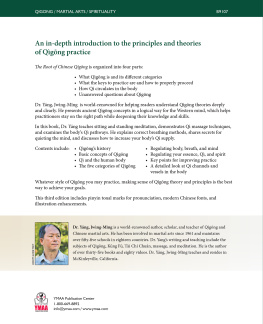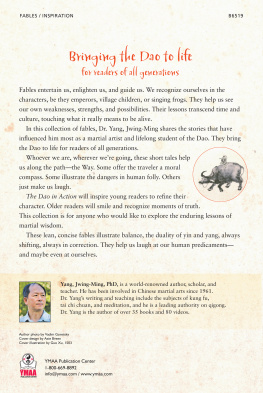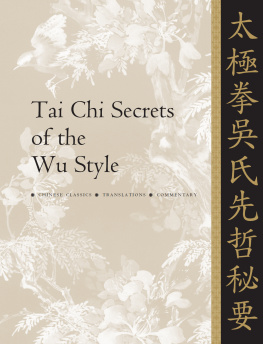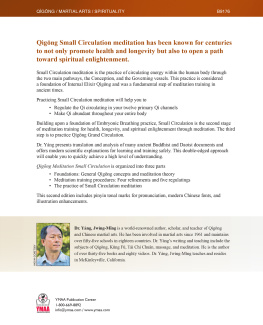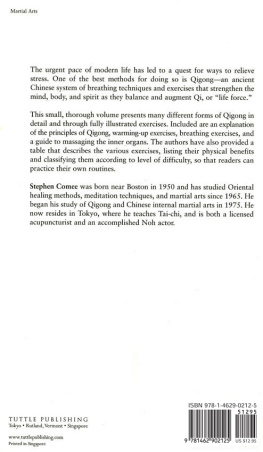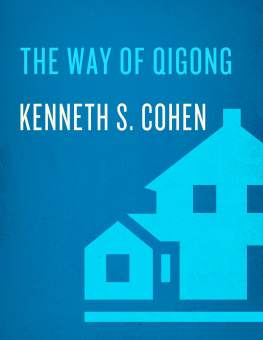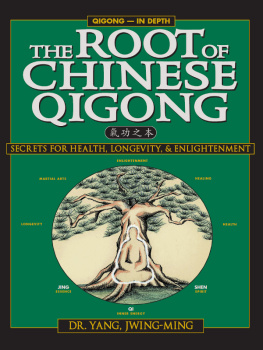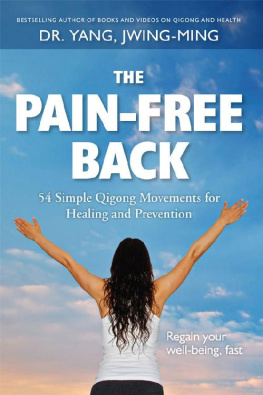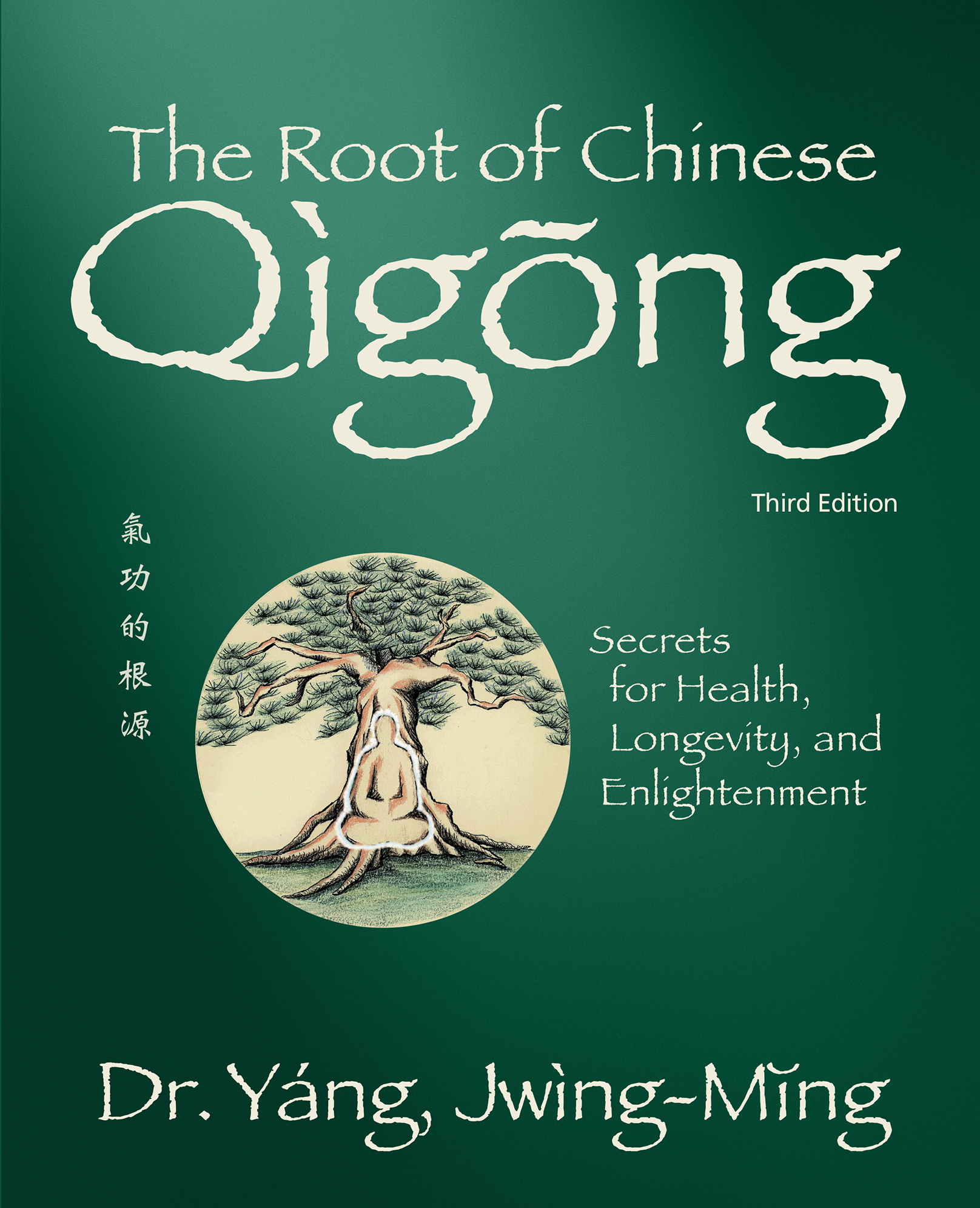Contents
List of Figures
List of Tables
Guide
Pagebreaks of the Print Version
The Root ofChinese
Qgng
Secrets
for Health,
Longevity, and
Enlightenment
Dr. Yng, Jwng-M
YMAA Publication Center
Wolfeboro, NH USA
YMAA Publication Center
PO Box 480
Wolfeboro, NH, 03894
1-800-669-8892
Third Edition Copyright 1989, 1997, 2022
ISBN 9781594399107 (print) ISBN 9781594399114 (ebook) ISBN 9781594399121 (hardcover)
This book set in EB Garamond and Avenir.
All rights reserved including the right of reproduction in whole or in part in any form.
Copyright 2022 by Yng, Jwng-Mng
Copyedit by Doran Hunter
Cover design by Axie Breen
Photos by YMAA Publication Center unless otherwise noted.
20220906
Publishers Cataloging in Publication
Names: Yang, Jwing-Ming, 1946- author.
Title: The root of Chinese qgng = [Qi gong zhi ben] : secrets for health, longevity, & enlightenment / Dr. Yng, Jwng-Mng.
Other titles: Qi gong zhi ben.
Description: Third edition. | Wolfeboro, NH : YMAA Publication Center, [2022] | Revision of the 1997 edition. | Text in English, with some Chinese characters included. | Includes bibliographical references, translation and glossary of Chinese terms, and index.
Identifiers: ISBN: 9781594399107 (softcover) | 9781594399114 (ebook) | 978194399121 (hardcover) | LCCN: 2022936180
Subjects: LCSH: Qi gong. | Qi gong--Therapeutic use. | Qi (Chinese philosophy) | Mind and body. | Well-being. | Meditation. | Spiritual care (Medical care) | Spirituality. | Medicine, Chinese. | Holistic medicine. | BISAC: BODY, MIND & SPIRIT / Healing / Energy (Qigong, Reiki, Polarity) | BISAC: HEALTH & FITNESS / Tai Chi. | BODY, MIND & SPIRIT / Healing / Energy (Qigong, Reiki, Polarity) | PHILOSOPHY / Mind & Body. | SPORTS & RECREATION / Martial Arts / General.
Classification: LCC: RA781.8 .Y364 2022 | DDC: 613.7/1489--dc23
The authors and publisher of this material are NOT RESPONSIBLE in any manner whatsoever for any injury which may occur through reading or following the instructions in this manual.
The activities, physical or otherwise, described in this material may be too strenuous or dangerous for some people, and the reader(s) should consult a physician before engaging in them.
Neither the authors nor the publisher assumes any responsibility for the use or misuse of information contained in this book.
Figures are used by permission from the LifeART Collection of Images 1989-1997 by Techpool Studios, Cleveland, OH.
To My Brother Dr. Tim Chn-Cheh Yng
Contents
Introduction
Qgng () is the science of cultivating the bodys internal energy, which is called Q () in Chinese. The Chinese have been researching Q for the last four thousand years and have found Qgng to be an effective way to improve health and to cure many illnesses. Most important of all, however, they have found that it can help them to achieve both mental and spiritual peace.
Until recently, Qgng training was usually kept secret, especially within martial arts systems or religions such as Buddhism and Daoism. Only acupuncture and some health-related Qgng exercises were available to the general public. During the last forty years, these secrets have become available to the general public through publications and open teaching. Medical professionals have finally been able to test Qgng more widely and scientifically, and they have found that it can help or cure a number of diseases that Western medicine has difficulty treating, including some forms of cancer. Many of my students and readers report that after practicing Qgng, they have changed from being weak to strong, from depressed to happy, and from sick to healthy.
Since Qgng can bring so many benefits, I feel that it is my responsibility to collect the available published documents and compile them, filter them, understand them, and introduce them to those who cannot read them in their original Chinese. It is, however, impossible for one person alone to experience and understand the fruit of four thousand years of Qgng research. I hope that other Qgng experts will share this responsibility and publish the information that they have been taught, as well as what they have learned through research and experimentation.
Even though Qgng has been researched in China for four thousand years, there are still many questions which can only be answered through recourse to todays technology and interdisciplinary knowledge. Contemporary, enthusiastic minds will have plenty of opportunity to research and promote the art. This is not a job that can be done through one individuals effort. It requires a group of experts, including Western-style doctors, Qgng experts, acupuncturists, and equipment-design specialists to sit down and work together and exchange their research results. A formal organization with adequate financial support will be needed. If this research is properly conducted, it should succeed not only in providing validation of Qgng for the Western mind, but it may also come up with the most efficient methods of practice. I feel certain that Qgng will become very popular in a short time and bring many people a healthier and happier life. This is a new field for Western science, and it will need a lot of support to catch up to the research that has already been done in China. I hope sincerely that Qgng science will soon become one of the major research fields in colleges and universities in this country.
Foreword
Thomas G. Gutheil, M.D.
First Edition
When Nixon opened China to the West in the 1970s, great interest was kindled in the possibilities of Americans learning many previously hidden secrets of the inscrutable Orient. One of the realms of exploration most eagerly awaited, particularly by Western physicians, was the science of Oriental healing: exotic practices such as acupuncture, Shiatsu massage, Tijqun, and the curious and puzzling notion of Q, or vital energy. Popular magazines at the time featured arresting photographs of men and women lying calmly on operating tables, nearly disemboweled during major surgery, yet apparently requiring no more anesthesia than a few gleaming needles thrust into the skin of their foreheads.
Since these earliest dramatic harbingers, serious investigation of phenomena based on Chinese conceptualizations have both waxed and waned. Interest in Tijqun, for examplea form of exercise, health maintenance, and combathas risen steadily, especially in the western United States, stimulated in part by the fact that a large part of the Chinese citizenry practices this exercise daily to apparently good effect, and in part by the fact that Tijqun masters, who regularly win mixed martial arts tournaments, seem to become better with age, rather than slower and weaker as do aging practitioners of other martial forms such as Gngf.
In contrast, after a spate of studies and articles attempting to define the physiologic bases for the generally unchallenged efficacy of acupuncture, interest in this area has waned markedly. Most early investigators tended toward the beliefs either that some form of suggestibility was involved, like that of hypnosis, another time-honored and effective anesthetic; or else that some known neural mechanism was being employed, such as gating, where stimulation of some nerves with acupuncture needles functionally blocked impulses (presumably pain impulses) in others.

